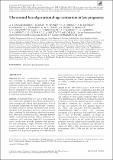Ultrasound-based gestational-age estimation in late pregnancy
Abstract
Objectives . Accurate gestational age (GA) estimation, preferably by ultrasound measurement of fetal crown rump length before 14 weeks’ gestation, is an important component of high-quality antenatal care. The objective was to determine how GA can best be estimated by fetal ultrasound for women who present for the first time late in pregnancy with uncertain or unknown menstrual dates. Methods. INTERGROWTH-21st was a large, prospective, multicentre, population-based project performed in eight geographically defined urban populations. One of its principal components, the Fetal Growth Longitudinal Study (FGLS), aimed to develop international fetal growth standards. Each participant had certain menstrual dates confirmed by first trimester ultrasound. Fetal head circumference (HC), biparietal diameter (BPD), occipitofrontal diameter (OFD), abdominal circumference (AC) and femur length (FL) were measured every 5 weeks from 14 weeks’ gestation until birth. For each participant, a single, randomly selected ultrasound examination was used to explore all candidate biometric variables and permutations to build models to predict GA. Regression equations were ranked based upon minimization of the mean prediction error, goodness of fit and model complexity. An automated machine learning algorithm, the Genetic Algorithm, was adapted to evaluate >64,000 potential polynomial equations as predictors. Results . Of the 4607 eligible women, 4321 (94%) had a pregnancy without major complications and delivered a live singleton without congenital malformations. After other exclusions (missing measurements in GA window and outliers), the final sample comprised 4229 women. Two skeletal measures, HC and FL, produced the best GA prediction, given by the equation loge(GA) = 0.03243 x (loge(HC))2 + 0.001644 x FL x loge(HC) + 3.813. When FL is not available, the best equation based on HC alone is loge(GA) = 0.05970 x (loge(HC))2 + 0.000000006409 x (HC)3 + 3.3258. The estimated uncertainty of GA prediction (half width 95% interval) was 6-7 days at 14 weeks’ gestation, 12-14 days at 26 weeks’ gestation, and > 14 days in the third trimester. The addition of FL to HC leads to improved prediction intervals over just using HC, but no further improvement in prediction is afforded by adding AC, BPD or OFD. Equations that included other measurements (BPD, OFD and AC) did not perform better. Conclusions . Among women initiating antenatal care late in pregnancy a single set of ultrasound measurements combining HC and FL in the second trimester can be used to estimate GA with reasonable accuracy. We recommend this tool for underserved populations but considerable efforts should be implemented to improve early initiation of antenatal care worldwide.
Citation
Papageorghiou , A T , Kemp , B , Stones , W , Ohuma , E O , Kennedy , S H , Purwar , M , Salomon , L J , Altman , D G , Noble , J A , Bertino , E , Gravett , M G , Pang , R , Cheikh Ismail , L , Barros , F C , Lambert , A , Jaffer , Y A , Victora , C G , Bhutta , Z A , Villar , J & Internatinal Fetal and Newborn Growth Consortium for the 21st Century (INTERGROWTH-21st) 2016 , ' Ultrasound-based gestational-age estimation in late pregnancy ' , Ultrasound in Obstetrics & Gynecology , vol. 48 , no. 6 , pp. 719-726 . https://doi.org/10.1002/uog.15894
Publication
Ultrasound in Obstetrics & Gynecology
Status
Peer reviewed
ISSN
1469-0705Type
Journal article
Description
This project was supported by a generous grant from the Bill & Melinda Gates Foundation to the University of Oxford.Collections
Items in the St Andrews Research Repository are protected by copyright, with all rights reserved, unless otherwise indicated.

